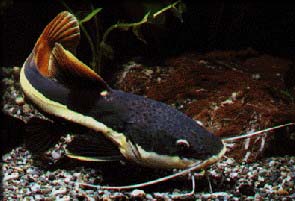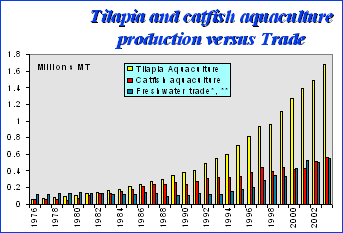|
-
Several business opportunities - component parts of the Integrated Developing Scheme described in Africans, Stop Being Poor! are listed in following table.
| a-
SHEA BUTTER (5,
6, 7,
11, 12,
13)
b- BLUE GOLD (14,
15, 16,
17, 18,
19)
c- FREEZE-DRIED PAPAIN (20,
21, 22
and here)
d-
KENAF (23,
24)
e- VEGETABLE OIL (25,
26, 27,
28)
f- CEREALS (30,
31, 32,
33)
g- FRUITS (34,
35, 36,
37, 38,
39, 40,
42, 43,
44, 45,
46)
h- ESSENTIAL OILS (47,
48, 49,
50, 51,
52)
i- ROOTS & TUBERS (54,
55, 56,
57, 58,
59, 60,
61, 62,
63, 64)
j-
FOWL BREEDING (66,
67, 68,
69, 70,
71, 72, 73, 74, 75, 76)
k- FISH FARMING (78, 79, 80, 81, 82, 83, |
-
FISH FARMING AS BUSINESS OPPORTUNITY: PART
V - CATFISH BREEDING CHARACTERISTICS AND WORLD MARKET
There are two ways to establishing fishing-farms: 1- Labor-intensive and 2- Capital-intensive.
In the first case,
the cost of labor is, most of the time, the main factor to consider to keep production costs at bay. In capital-intensive ventures high feed costs are the primary limiting factor in terms of production costs.
A fishing-farm venture will be economically feasible if products can be produced and sold at competitive prices against other animal-protein sources (meat and chicken meat). For that reason, most of the times, fish-farming operations are vertically integrated from fingerlings production to the final product to be sold on marketplace: whole fresh fish, fresh filets or transformed fish such as salted, smoked or sun dried fish.
In anticipation to the Economics of a Small-Scale Fish-Farming Operation based on the polyculture of Tilapia and Catfish, we shall, in this issue, further consider Catfish's breeding characteristics and potential market - worldwide.
- CATFISH BREEDING CHARACTERISTICS
 Catfish are generally produced by allowing brooder catfish to spawn in shallow
open ponds, then collecting the egg masses and incubating them in indoor
hatcheries or in (deep) outdoors ponds. Catfish are generally produced by allowing brooder catfish to spawn in shallow
open ponds, then collecting the egg masses and incubating them in indoor
hatcheries or in (deep) outdoors ponds.
Ponds for catfish production generally run from 2 to 10 acres. Standard (well managed) pond production of catfish is 25,000-40,000 lb/acre. [11 to 18 kg/acre]
Channel cattish, Ictalurus punctatus (Rafinesque), is the most important species of
aquatic animal commercially cultured in the world and particularly in the United States. It belongs to the family
Ictaluridae, order Siluriformes. Members of the order Siluriformes are found in fresh and
salted water worldwide.
African catfish species are here listed. [Lake Nasser in Egypt is full of catfish (the dam holds back the mud and silt that the catfish like
to live in), and Egyptians do not harvest them as - for cultural reasons - they consider Catfish not suitable for food: Source]
In North America, there is a thriving catfish industry that relies on 6 of the 39 species available: the blue
catfish, Ictalurus furcatus (LeSueur); the white catfish, Ictalurus catus (Linnaeus); the
black bullhead, Ictalurus melas (Rafinesque); the brown bullhead, Ictalurus nebulosus
(LeSueur); the yellow bullhead, Ictalurus natalis (LeSueur); and the flathead catfish, Pylodictis olivaris (Rafinesque).
In natural waters channel catfish live
in moderate to swiftly flowing
streams, but they are also abundant
in large reservoirs, lakes, ponds and
some sluggish streams. They are
usually found where bottoms are
sand, gravel or rubble, in preference
to mud bottoms. Channel
catfish are freshwater fish but
they can thrive in brackish water.
Channel catfish generally prefer
clear water streams, but are common
and do well in muddy water - particularly in Africa.
Feeding can occur during day or
night, and they eat a wide variety
of both plant and animal material.
Channel catfish usually feed near the
bottom in natural waters but will
take some food from the surface.
Based on stomach analysis, young
catfish feed primarily on aquatic insects.
Adults have a much more
varied diet which includes insects,
snails, crawfish, green algae, aquatic
plants, seeds and small fish. When
available, they will feed avidly on terrestrial
insects, and there are even
records of birds being eaten.
Channel catfish grow best in warm
water with optimum growth occurring
at temperatures of about 85° F
(29.4° C). With each 18° F (10° C)
change in temperature there is a
doubling or halving of their metabolic
rate. This means that within
limits, their appetite increases with
increasing water temperatures or
decreases with decreasing water
temperatures.
The
size and age that channel catfish
reach in natural waters depends on
many factors. Age and growth
studies have shown that in many
natural waters channel catfish do not
reach 1 pound in size until they are 2
to 4 years old.
In production ponds the mouth rate
of channel catfish is determined by
water temperature; length of time
held at different water temperatures;
quantity and quality of food fed;
palatability, or taste of food; frequency
of feeding; water quality, etc.
Most farm-raised catfish are harvested
at a weight of 11/4 pounds at
an age of about 18 months. [Source]
| DEFINITIONS USED FOR CATFISH PRODUCTION |
Broodfish - Fish kept for egg production, including males. Broodfish produce the fertilized eggs which go to hatcheries. The most desirable size is 3 to 10 pounds or 4 to 6 years of age.
Large Foodsize - Fish weighing over 3 pounds.
Medium Foodsize - Fish weighing over one and one-half pounds to 3 pounds.
Small Foodsize - Fish weighing over three-fourths pound to one and one-half pounds.
Large Stockers - Fish weighing over 180 pounds to 750 pounds per 1,000 fish.
Small Stockers - Fish weighing over 60 pounds to 180 pounds per 1,000 fish.
Fingerlings/ Fry - Fish weighing 60 pounds per 1,000 fish and less. |
- POSSIBLE FINGERLING SUPPLY' SOURCES
Catfish Farmers of America, phone +1 662 887-2699, is the trade association that
represents catfish farmers across the U.S. Its main publication is The Catfish Journal. Alabama Catfish Producers. The organization also works closely with the Department of Fisheries and Allied Aquacultures at Auburn University, USDA, Agricultural Research Service, Aquatic Animal Health Research Unit and the Alabama Cooperative Extension System to determine research needs and provide information for Alabama producers.
There are research stations around African continent specialized in fingerling production for Tilapia - Particularly in Egypt, and South Africa.
On the international marketplace Vietnam's catfish industry could be a good supply' source; Wageningen University in Holland and the University of Florida in the United States of America are other reliable sources that provide information on warm water fishing techniques.
CATFISH MARKET SIZE IN AFRICAN COUNTRIES AND WORLDWIDE
In most African countries, there are, here and there, research stations on fish-farming development. But sadly enough, such researches had not resulted into full promotional activities to establish Catfish as protein provider for the populations.
 Indeed, currently (end of 2005) not a single sub-Saharan African country had a promotion plan for the extensive culture of Catfish. One could therefore consider the African market for Catfish to be potentially a huge one for whole fresh product and transformed products such as smoked and sun-dried catfish. Indeed, currently (end of 2005) not a single sub-Saharan African country had a promotion plan for the extensive culture of Catfish. One could therefore consider the African market for Catfish to be potentially a huge one for whole fresh product and transformed products such as smoked and sun-dried catfish.
Considering an intake of one (the strict minimum) whole catfish per African, per month, one could estimate the market size to be in the range of minimum 3,264,000 metric ton a year. [400g x 680,000,000 (Africans) x 12 (months)]. Imagine what the potential would be if one consider a daily intake of one whole tilapia fish per inhabitant!
Catfish and Tilapia could be used by African economic planners as perfect Income Building Operations for rural communities in African countries. That is the breeding of both species could provide cash on a sustainable basis to rural folks throughout Africa.
Based on previous deliveries' contents, the next issue 83 (March 15, 2006) will expose investments briefs about a small-scale polyculture operation concerning Tilapia and Catfish's breeding.
Adobe
Acrobat Reader is available here
- Interested parties - private African and international investors /
companies, government
agencies,
international development
agencies - to make contact through the Free Access Support Console available at this link
Contact through the support console will get quickest reply from Africabiz Online's staff, than contact by emails. Click here for contact information. Be advised that first contact should be through the support console to be followed by phone calls. If you are a VIP-Member, use VIP-Members Support Console available here.
Before you consult please click
here to review this clarification |

